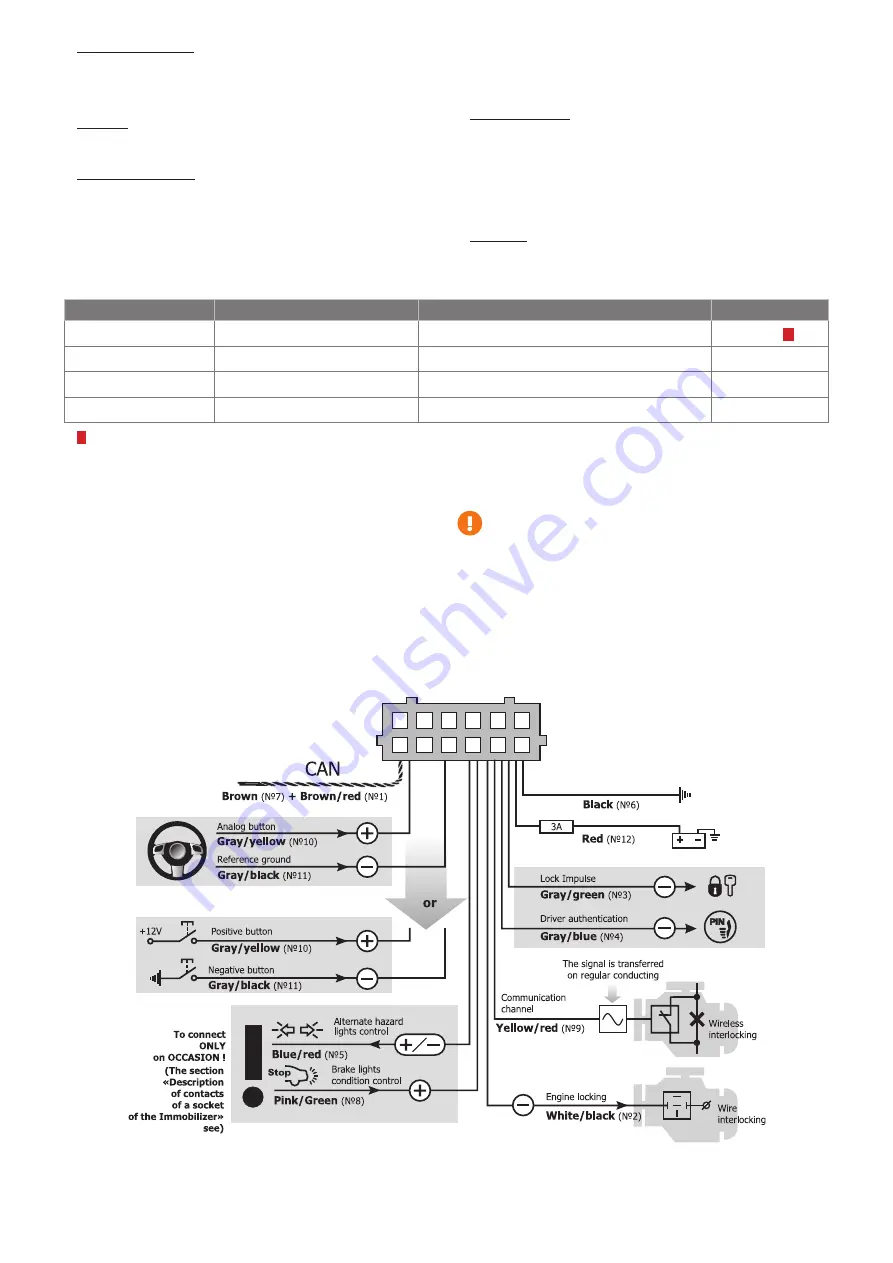
5
Pin No. 8 “(+) input”. Brake lights control. It is used only in cases
when vehicle CAN bus does not contain data on brake pedal position (see
Integrator files). In such cases input No. 8 is to be connected to brake
pedal terminal switch output. Should the CAN bus contain brake pedal
position data the input’s function is lost and can be restored only when
settings are reset to factory default ones.
Pin No. 9.
“Communication channel” is connected to positive polarity
commutative voltage vehicle circuit that is used for communication with
main unit and locking relay. Upon installing the Immobilizer it is neces-
sary to check the communication in between the main unit and the relay.
Pin No. 10 “(-) input. Analog button/Positive button”. Depending
on control button type choice one of the following functions is used:
◊
Analog button is connected to the corresponding vehicle wire
at the steering wheel contact helix port (see Integrator files).
◊
Positive button is connected to the positive button (the one controlled
by +12V voltage). It is used in case if there are no original vehicle
buttons perceived by the Immobilizer.
If the vehicle has original buttons controlled via CAN bus that are per-
ceived by the Immobilizer, this input may be discarded.
Pin No. 11 (-) input. Depending on control button choice one of the fol-
lowing functions is used:
◊
Analog button is connected to the corresponding vehicle wire
at the steering wheel contact helix port (see Integrator files).
◊
Negative button is connected to the negative button (the
one controlled by ground fault). It is used in case if there
are no original vehicle buttons perceived by the Immobilizer.
If the vehicle has original buttons controlled via CAN bus that are per-
ceived by the Immobilizer, this input may be discarded.
Pin No. 12. Immobilizer power supply is connected through 3 A fuses
to one of vehicle wires that has +12 V non-commutated voltage.
pLine-221 relay description and installation recommendations
Table 2. Relay outputs description
Color
Type
Function
Current
Red
Communication channel
and power supply
+12 В
1 А/10 mА
1)
Black
Power supply
Ground
–
Violet
–
Locking output
10 А
Violet
–
Locking output
10 А
1)
Transfer mode (impulse): up to 1 A. Reception mode: 10 mA.
Communication channel outputs of the central unit and the relay need
to be connected to vehicle circuit with commutated positive polarity
voltage. The signal is to be present in this circuit when the engine
is one (e.g., ignition circuit, fuel pump, nuzzles, ignition coils etc.
can be used). The circuit that is used for communication in between
the central unit and the relay can be blocked (or other vehicle circuit
suitable for these purposes). Relay locking outputs are connected
to the circuit breaking in any order (it is irrelevant which one of them
is connected before the breaking and which one is connected after it).
Upon Immobilizer installation it is necessary to check the connection
in between the central unit and the relay.
The relay is equipped with a built-in accelerometer that is necessary
for vehicles that don’t have vehicle movement data in their CAN buses
and that also allows operating additional features for vehicles that
have movement data in their CAN bus. The features are as follows:
◊
Engine locking even in case if due to some reasons the central
unit receives wrong data on vehicle speed from the bus.
◊
Available accelerometer allows starting the engine in case
if the connection in between the central unit and relay has been
lost along with stopping the engine after the driving had begun.
It is not allowed to install more than one pLine-221 relay.
The relay should not be installed on vehicle parts that are subject
to engine starting and operation vibrations. Such installation may com-
promise vehicle movement identification due to a significant amount
of noises overlaying the useful signal.
Factory-set sensitivity setting is based on the assumption that the re-
lay is located and fixed in a way that engine operation and starting
vibrations’ transferred to the unit are minimized.
Upon Immobilizer installation it is necessary to check accelerometer
sensitivity settings and adjust them should it be necessary.
PRIZRAK-520 Immobilizer connection diagram (factory default settings)






























